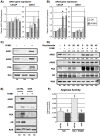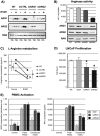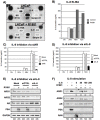Androgen-regulated expression of arginase 1, arginase 2 and interleukin-8 in human prostate cancer
- PMID: 20711410
- PMCID: PMC2920336
- DOI: 10.1371/journal.pone.0012107
Androgen-regulated expression of arginase 1, arginase 2 and interleukin-8 in human prostate cancer
Abstract
Background: Prostate cancer (PCa) is the most frequently diagnosed cancer in North American men. Androgen-deprivation therapy (ADT) accentuates the infiltration of immune cells within the prostate. However, the immunosuppressive pathways regulated by androgens in PCa are not well characterized. Arginase 2 (ARG2) expression by PCa cells leads to a reduced activation of tumor-specific T cells. Our hypothesis was that androgens could regulate the expression of ARG2 by PCa cells.
Methodology/principal findings: In this report, we demonstrate that both ARG1 and ARG2 are expressed by hormone-sensitive (HS) and hormone-refractory (HR) PCa cell lines, with the LNCaP cells having the highest arginase activity. In prostate tissue samples, ARG2 was more expressed in normal and non-malignant prostatic tissues compared to tumor tissues. Following androgen stimulation of LNCaP cells with 10 nM R1881, both ARG1 and ARG2 were overexpressed. The regulation of arginase expression following androgen stimulation was dependent on the androgen receptor (AR), as a siRNA treatment targeting the AR inhibited both ARG1 and ARG2 overexpression. This observation was correlated in vivo in patients by immunohistochemistry. Patients treated by ADT prior to surgery had lower ARG2 expression in both non-malignant and malignant tissues. Furthermore, ARG1 and ARG2 were enzymatically active and their decreased expression by siRNA resulted in reduced overall arginase activity and l-arginine metabolism. The decreased ARG1 and ARG2 expression also translated with diminished LNCaP cells cell growth and increased PBMC activation following exposure to LNCaP cells conditioned media. Finally, we found that interleukin-8 (IL-8) was also upregulated following androgen stimulation and that it directly increased the expression of ARG1 and ARG2 in the absence of androgens.
Conclusion/significance: Our data provides the first detailed in vitro and in vivo account of an androgen-regulated immunosuppressive pathway in human PCa through the expression of ARG1, ARG2 and IL-8.
Conflict of interest statement
Figures





Similar articles
-
Androgens suppress EZH2 expression via retinoblastoma (RB) and p130-dependent pathways: a potential mechanism of androgen-refractory progression of prostate cancer.Endocrinology. 2010 Nov;151(11):5136-45. doi: 10.1210/en.2010-0436. Epub 2010 Sep 29. Endocrinology. 2010. PMID: 20881251 Free PMC article.
-
Fibroblast-derived exosomal microRNA regulates NKX3-1 expression in androgen-sensitive, androgen receptor-dependent prostate cancer cells.J Cell Biochem. 2023 Aug;124(8):1135-1144. doi: 10.1002/jcb.30435. Epub 2023 Jun 19. J Cell Biochem. 2023. PMID: 37334663
-
Down-regulation of calcium/calmodulin-dependent protein kinase kinase 2 by androgen deprivation induces castration-resistant prostate cancer.Prostate. 2012 Dec 1;72(16):1789-801. doi: 10.1002/pros.22533. Epub 2012 May 1. Prostate. 2012. PMID: 22549914
-
Biochemistry, pharmacology, and in vivo function of arginases.Pharmacol Rev. 2025 Jan;77(1):100015. doi: 10.1124/pharmrev.124.001271. Epub 2024 Nov 22. Pharmacol Rev. 2025. PMID: 39952693 Free PMC article. Review.
-
Androgen action in the prostate gland.Minerva Urol Nefrol. 2012 Mar;64(1):35-49. Minerva Urol Nefrol. 2012. PMID: 22402316 Review.
Cited by
-
Arginase Isoform Expression in Chronic Rhinosinusitis.J Clin Med. 2019 Nov 1;8(11):1809. doi: 10.3390/jcm8111809. J Clin Med. 2019. PMID: 31683763 Free PMC article.
-
Assessment of Serum Urea, Creatinine and Uric Acid in Oral Cancer.J Clin Med. 2022 Jun 16;11(12):3459. doi: 10.3390/jcm11123459. J Clin Med. 2022. PMID: 35743528 Free PMC article.
-
Tumor microenvironment antigens.Semin Immunopathol. 2023 Mar;45(2):253-264. doi: 10.1007/s00281-022-00966-0. Epub 2022 Sep 29. Semin Immunopathol. 2023. PMID: 36175673 Free PMC article. Review.
-
Aging-Associated Alterations in Mammary Epithelia and Stroma Revealed by Single-Cell RNA Sequencing.Cell Rep. 2020 Dec 29;33(13):108566. doi: 10.1016/j.celrep.2020.108566. Cell Rep. 2020. PMID: 33378681 Free PMC article.
-
Acute myeloid leukemia creates an arginase-dependent immunosuppressive microenvironment.Blood. 2013 Aug 1;122(5):749-58. doi: 10.1182/blood-2013-01-480129. Epub 2013 Jun 3. Blood. 2013. PMID: 23733335 Free PMC article.
References
-
- Jemal A, Siegel R, Ward E, Hao Y, Xu J, et al. Cancer statistics, 2008. CA Cancer J Clin. 2008;58:71–96. - PubMed
-
- Grossmann ME, Huang H, Tindall DJ. Androgen receptor signaling in androgen-refractory prostate cancer. J Natl Cancer Inst. 2001;93:1687–1697. - PubMed
-
- Chang SS, Kibel AS. The role of systemic cytotoxic therapy for prostate cancer. BJU Int. 2009;103:8–17. - PubMed
Publication types
MeSH terms
Substances
LinkOut - more resources
Full Text Sources
Other Literature Sources
Medical
Research Materials
Miscellaneous

